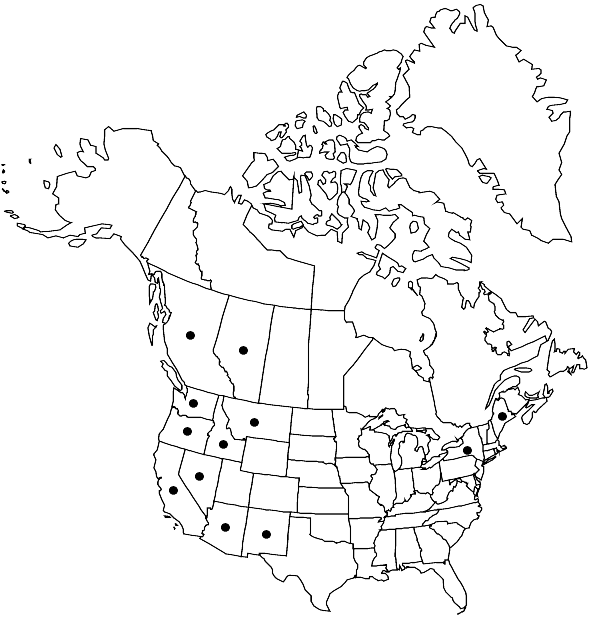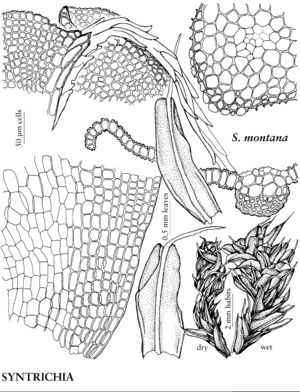Difference between revisions of "Syntrichia montana"
Flora 2: 301. 1819,.
FNA>Volume Importer |
imported>Volume Importer |
||
| (6 intermediate revisions by 2 users not shown) | |||
| Line 10: | Line 10: | ||
|name=Syntrichia intermedia | |name=Syntrichia intermedia | ||
|authority=Bridel | |authority=Bridel | ||
| − | }}{{Treatment/ID/Synonym | + | |rank=species |
| + | }} {{Treatment/ID/Synonym | ||
|name=Tortula intermedia | |name=Tortula intermedia | ||
|authority=(Bridel) De Notaris | |authority=(Bridel) De Notaris | ||
| − | }}{{Treatment/ID/Synonym | + | |rank=species |
| + | }} {{Treatment/ID/Synonym | ||
|name=Tortula ruralis var. crinita | |name=Tortula ruralis var. crinita | ||
|authority=De Notaris | |authority=De Notaris | ||
| + | |rank=variety | ||
}} | }} | ||
|hierarchy=Pottiaceae;Pottiaceae subfam. Pottioideae;Syntrichia;Syntrichia montana | |hierarchy=Pottiaceae;Pottiaceae subfam. Pottioideae;Syntrichia;Syntrichia montana | ||
| Line 30: | Line 33: | ||
|elevation=moderate to high elevations | |elevation=moderate to high elevations | ||
|distribution=Alta.;B.C.;Ariz.;Calif.;Idaho;Maine;Mont.;Nev.;N.Mex.;N.Y.;Oreg.;Wash.;Europe;Asia. | |distribution=Alta.;B.C.;Ariz.;Calif.;Idaho;Maine;Mont.;Nev.;N.Mex.;N.Y.;Oreg.;Wash.;Europe;Asia. | ||
| − | |discussion=<p>This treatment follows M. T. Gallego et al. (2006) in employing Syntrichia montana to encompass what has been called S. intermedia or S. ruralis var. crinita in North America. This is, however, a tentative decision as there remains an incompletely understood complex of small, dioicous plants with hydroids in the costa, and some currently undescribed taxa may yet need to be recognized. One recently described species that falls in this complex is S. rupicola B. H. Allen. Further field sampling, molecular characterization, and culture studies are necessary before these taxa are fully understood.</p> | + | |discussion=<p>This treatment follows M. T. Gallego et al. (2006) in employing <i>Syntrichia montana</i> to encompass what has been called <i>S. intermedia</i> or <i>S. ruralis</i> <i></i>var.<i> crinita</i> in North America. This is, however, a tentative decision as there remains an incompletely understood complex of small, dioicous plants with hydroids in the costa, and some currently undescribed taxa may yet need to be recognized. One recently described species that falls in this complex is <i>S. rupicola</i> B. H. Allen. Further field sampling, molecular characterization, and culture studies are necessary before these taxa are fully understood.</p> |
|tables= | |tables= | ||
|references= | |references= | ||
| Line 39: | Line 42: | ||
-->{{#Taxon: | -->{{#Taxon: | ||
name=Syntrichia montana | name=Syntrichia montana | ||
| − | |||
|authority=Nees | |authority=Nees | ||
|rank=species | |rank=species | ||
| Line 53: | Line 55: | ||
|publication year= | |publication year= | ||
|special status= | |special status= | ||
| − | |source xml=https:// | + | |source xml=https://bitbucket.org/aafc-mbb/fna-data-curation/src/2e0870ddd59836b60bcf96646a41e87ea5a5943a/coarse_grained_fna_xml/V27/V27_912.xml |
|subfamily=Pottiaceae subfam. Pottioideae | |subfamily=Pottiaceae subfam. Pottioideae | ||
|genus=Syntrichia | |genus=Syntrichia | ||
Latest revision as of 21:29, 5 November 2020
Stems 2–10 mm. Leaves infolded and twisted when dry, erect-spreading when moist, lingulate or spatulate, 1.5–3 × 0.5–1.5 mm; margins revolute in the proximal 1/2, entire; apices broadly acute or obtuse, sometimes emarginate; costa excurrent into a short, serrate, hyaline awn, brown or red, often papillose abaxially and serrulate near the apex because of projecting cell ends; basal cells abruptly differentiated, narrower toward the margins; distal cells polygonal or quadrate, 8–12 µm, with 4–6 papillae per cell. Specialized asexual reproduction absent. Sexual condition dioicous. Seta red, 8–14 mm. Capsule red, 2–3.5 mm, straight or slightly curved; operculum 1.2–2 mm, red; peristome 0.5–1.3 mm, the basal membrane to 1/2 the total length, red. Spores 10–13 µm, papillose.
Habitat: Widespread on soil and rock, occasionally on tree bark
Elevation: moderate to high elevations
Distribution

Alta., B.C., Ariz., Calif., Idaho, Maine, Mont., Nev., N.Mex., N.Y., Oreg., Wash., Europe, Asia.
Discussion
This treatment follows M. T. Gallego et al. (2006) in employing Syntrichia montana to encompass what has been called S. intermedia or S. ruralis var. crinita in North America. This is, however, a tentative decision as there remains an incompletely understood complex of small, dioicous plants with hydroids in the costa, and some currently undescribed taxa may yet need to be recognized. One recently described species that falls in this complex is S. rupicola B. H. Allen. Further field sampling, molecular characterization, and culture studies are necessary before these taxa are fully understood.
Selected References
None.
